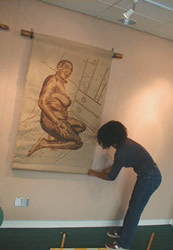Philomena Francis - Artist
Artist Statement
 My art practice contains and reflects my interest and enquiry into the site of the black female body, and its relationship to the contemporary socio-cultural context and colonial history. This approach has aroused core questions about identity on many levels such as national and sexual. What intrigues me is the complexity of how the meaning and experience of viewing the black body or the female body in certain contexts can be problematic and be home to many contradictions.
My art practice contains and reflects my interest and enquiry into the site of the black female body, and its relationship to the contemporary socio-cultural context and colonial history. This approach has aroused core questions about identity on many levels such as national and sexual. What intrigues me is the complexity of how the meaning and experience of viewing the black body or the female body in certain contexts can be problematic and be home to many contradictions.
By using brown sugar in the Brown Sugar Series (2004) and moving on to the sugar-based substance of black treacle as my main creative material, I’m relating to the issue of how the material can reference a whole stream of associations and physical sensations. The sugar-based substance interacts with the imagery it creates, and the lines and drips either attracts the viewer or pushes them away. By creating the work on the actual walls of an institution or gallery I create yet another layer of meaning as the history of territory becomes part of the work.
mo’lasses II (2006) is a mixed media installation where piped black treacle is used to create a black female image repeatedly on walls which I have already painted in colours reminiscent of the Georgian period. The paints were specifically chosen with names that reflect the complex relationship between European and African history.
In popular culture, there is an implied association between brown sugar, the black body and black female sexuality. ‘mo’lasses II’ and Black Treacle Series (2007) play with this association by using the brown sugar substance of black treacle which resembles the residue left behind from the sugar refining process. This residual material creates a fluidity associated with sexuality while keeping the unrefined rawness that is often linked with brown sugar when compared to white sugar.
The drips and scent of both pieces also engages the viewers’ senses, creating an urge to touch, smell and taste the work. This reflects the simulation of the human senses in a sexual context. The black treacle also references the pain of slavery and the colonial legacy of the sugar trade in a subtle way and the covert but extensive effects the colonial relationship has on the site of the black female body and identity.
The images in the mo’lasses II and mo’lasses III (2007) aim to re-appropriate and recreate images of black women that are more authentic, whereas the images in Black Treacle Series will aim to re-appropriate a number of past, present and possible future iconic images and create new meanings.
TOPˆ